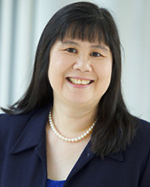|
University of Maryland (UMD) MATRIX Lab affiliate faculty members are solving real-world problems with their research.
 Dr. Mumu Xu (AE/ISR/MRC/MATRIX) is working to ensure systems that rely on AI and/or machine learning are reliable and trustworthy, especially as they grow increasingly complex. Her research focuses on how to show that systems are going to make decisions that are safe and correct, and the tests needed to support that. She worked on that challenge with Donald "Bucket" Costello when he was a PhD student. He’s now the lab’s Director of Test and Evaluation of Autonomous Systems. Dr. Mumu Xu (AE/ISR/MRC/MATRIX) is working to ensure systems that rely on AI and/or machine learning are reliable and trustworthy, especially as they grow increasingly complex. Her research focuses on how to show that systems are going to make decisions that are safe and correct, and the tests needed to support that. She worked on that challenge with Donald "Bucket" Costello when he was a PhD student. He’s now the lab’s Director of Test and Evaluation of Autonomous Systems.
The systems Dr. Xu works with range from sea to space and can include satellites, airplanes, cars, and more, but many of her projects involve flying drones. Southern Maryland offers a great environment for her operational research. Fewer flight restriction zones make it easier to fly outside, and the Open Air-Land Lab’s (OAL) Vicon camera system allow her to track and replay indoor flights with high accuracy. Close proximity to the UAS Research and Operations Center (UROC) makes it easy to get expert consultations and guidance from UROC engineers. Any ground vehicle testing can be done on the MATRIX Lab’s UGV playground, which offers a variety of obstacles for vehicles to navigate.
Dr. Xu is positively impacting Southern Maryland through her collaborative work with NAWCAD. She is ensuring that the region’s end users, technicians, and engineers have the systems they need, and that those systems are safe and reliable to work with.
“We have the advantage of all of the connections we have down in Southern Maryland. We can talk to operators who will actually use these systems and find out what features they need and what would be useful for them,” Dr. Xu said. “We can work together to try to solve a real-life problem that professionals are facing.”
Dr. Xu’s positive impact also goes beyond the engineering field.
She is applying her AI expertise to a brand-new project aiming to help children with speech disorders. She is starting to look into how to integrate AI into augmentative and alternative communication (AAC) devices in order to improve communication.
 Dr. Ming Lin (CS/MRC/ECE/ISR/MATRIX) is using her expertise in human-robot collaboration and connected and mixed autonomy (ground and aerial) to tackle issues ranging from driving autonomously to training chat bots. Dr. Ming Lin (CS/MRC/ECE/ISR/MATRIX) is using her expertise in human-robot collaboration and connected and mixed autonomy (ground and aerial) to tackle issues ranging from driving autonomously to training chat bots.
As autonomous vehicles become more prevalent, Dr. Lin is working on ways to keep them connected in order to make driving more efficient. For example, if each vehicle knows the others’ location, it may be able to predict and avoid traffic jams. Since location sharing raises privacy concerns, Dr. Lin considers the balance of privacy and usability while conducting her work.
Dr. Lin is interested in testing air and ground vehicles in the MATRIX Lab’s OAL. In any possible future work with underwater robots, she has access to the OAL’s water tank as well as the MATRIX Lab’s water tunnel, which has a capacity of nearly 18,000 gallons.
“The MATRIX Lab is in a very unique location and has some great facilities for air, ground, and underwater vehicle research,” Dr. Lin said. “All these spaces are very accessible and in one state-of-the-art building, providing everything you need for testing your systems in one place.”
Beyond engineering, Dr. Lin’s research has many applications. She is currently working on a training tool that will help chat bots gather information on how diverse communities respond to messaging including public health/service announcements and advertisements. With her unique concepts, the bot would take people’s personalities into account when serving as a conversational AI agent to represent individuals of varying backgrounds in the community. She is collaborating with the UMD School of Public Health and Teaching and Learning Transformation Center to ensure the technology meets the needs of the people who will be using it for training students and public health workers to interact effectively with the communities at large.
In the healthcare field, she plans to use augmented reality to proactively monitor people’s health. In her Evening@SMART presentation on September 4, she discussed how to determine if an organ was healthy by using images of it to evaluate its tissue properties and disease progression. This would help determine if cancer cells are present without the need for an invasive biopsy.
Both Dr. Xu and Dr. Lin involve students in their work as a way to train the next generation of researchers and engineers. While students get useful, hands-on experience, the instructors get new perspectives and feedback that positively impacts their work.
View our full list of affiliate faculty here.
Related Articles:
MATRIX Lab Hiring Research Development Director
Department Welcomes New Faculty Member Tam Nguyen
Twelve University of Maryland Faculty Affiliate With MATRIX Lab
Wereley, Choi Honored with Outstanding Technical Paper Award at CAMX 2024
Inspired by Nature, Researchers Improve System Movement
Six Clark School Faculty Receive 2024 DURIP Awards
Maryland Engineers Awarded Grants to Address Humanity's Grand Challenges
Dylan Hurlock Receives Wings Club Foundation Scholarship
New Initiatives Push Toward Safe & Reliable Autonomous Systems
Four Aerospace Engineering Faculty Named AIAA Associate Fellows
April 14, 2025
|

